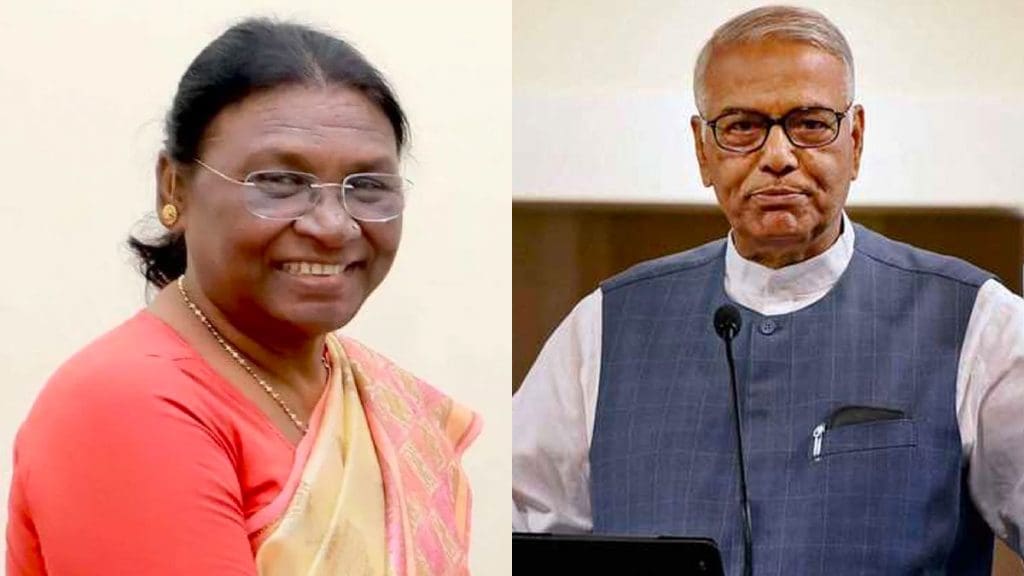
The Presidential Elections 2022 is scheduled for July 18th 2020. Meanwhile, the NDA and opposition have announced their respective candidates — Draupadi Murmu and Yashwant Sinha.
On Tuesday, BJP chief JP Nadda announced tribal leader and former governor of Jharkhand Draupadi Murmu as the BJP-led NDA alliance’s presidential candidate. Across the aisle, Congress leader – Jairam Ramesh announced Yashwant Sinha as the common candidate of the opposition for the opposition parties.
Current President of India Ram Nath Kovind’s terms will end on July 24th.
Who is NDA’s Draupadi Murmu?
Draupadi Murmu is a tribal leader and the former Governor of Jharkhand. If elected, she’ll become India’s first woman tribal President and second women President of India.
She was born in Odhisa’s Mayubhanj and did her Graduation from Rama Devi Women’s College in Bhubaneswar. She further taught at Shri Aurobindo Integral Education and Research as a junior assistant professor. She also served as a junior assistant in the irrigation department of the Odhisa government.
In a quick glance, here’s the career of Draupadi Murmu over the years:
- A teacher from Odhisa.
- In 1997, she entered politics after winning the post of councillor of the Rairanpur civic body.
- In 2000, she became MLA of Rairangpur.
- Between 2002-2004, she received critical portfolios in Odhisa’s BJP-BJD coalition government.
- In 2007, she received the ‘Nilakantha Award’ for best MLA honourably.
- Between 2002-2009, she was BJP’s ST morcha’s national executive.
- Between 2010-2015, she served as BJP’s Mayurbhanj unit president.
- In 2015, she became the first woman governor of Jharkhand.
Upon the announcement of Draupadi Murmu as a presidential candidate, Prime Minister – Narendra Modi tweeted praising the devotion and work of Draupadi Murmu.
PM Narendra Modi tweeted, “Smt. Droupadi Murmu Ji has devoted her life to serving society and empowering the poor, downtrodden as well as the marginalised. She has rich administrative experience and had an outstanding gubernatorial tenure. I am confident she will be a great President of our nation.”
“Millions of people, especially those who have experienced poverty and faced hardships, derive great strength from the life of Smt. Droupadi Murmu Ji. Her understanding of policy matters and compassionate nature will greatly benefit our country,” he further tweeted.
Who is Yashwant Sinha?
Yashwant Sinha is an Ex-BJP member who recently joined Trinamool Congress (TMC) in 2021. Mr Sinha started his career as an IAS officer and held key portfolios over the years.
Mr Sinha was born in Bihar’s Patna and did his Master’s in Political Science. Later, he also taught Political Science at Patna university before becoming an IAS officer.
It is worth mentioning that Yashwant Singha is the fourth choice of opposition after NCP chief – Sharad Pawar, Former J&K CM – Farooq Abdullah and former Governor of West Bengal declined to be a candidate.
In a quick glance, here’s the career of Yashwant Sinha over the years:
- In 1960, Mr Sinha became an IAS officer.
- In 1984, he joined politics as a member of the Janata Party after quitting IAS.
- From 1990-1991, he served as Union Minister of Finance.
- In 1996, he became BJP’s national spokesperson.
- In 1998, he served as Union Finance Minister in Atal Bihari Vajpayee’s government.
- In 2018, he announced retirement from active politics and quit BJP.
- In 2021, Mr Sinha joined TMC and became its vice-president.
The opposition gave a joint statement.
The opposition’s statement read, “We appeal to all political parties to support Yashwant Sinha as prez (president) so we can have a worthy ‘rashtrapati’ elected unopposed.”
Meanwhile, Mr Sinha tweeted, “I am grateful to Mamataji for the honour and prestige she bestowed on me in the TMC. Now a time has come when for a larger national cause I must step aside from the party to work for greater opposition unity. I am sure she approves of the step.”
Power and Authority of President of India
The President of India is the head of the Indian State. The commander in chief of the Indian Armed Forces. Per the constitution, the president’s role and responsibility are to protect India’s constitution. Meanwhile, the president’s power and authority can be divided into five groups – legislative, executive, appointing, military and pardoning.
Legislative Powers:
- Power to dissolve the lower house of the parliament.
- Bill passed by both the houses of parliament needs the stamp of the president to become a law.
- Power to nominate 12 members who have achieved significant accomplishment in the fields of art, science, social service and literature to the upper house of parliament.
- Power to send a bill back to parliament for review.
Executive Powers:
- India’s executive power is bestowed upon the president.
- President can be given more power by the parliament.
- President can delegate his powers to state governors.
Appointing Powers:
- President appoints the Prime Minister.
- President appoints Chief Justice.
- President can appoint and dismiss Governors.
- President can further appoint for various posts, including – Ambassadors, Attorney General, IFS, IAS, IPS, etc.
Military Powers:
- President is the commander in chief of all the armed forces.
- President can declare war or conclude peace with a country on advice from the prime minister and his council of ministers.
- Any treaty signed with any country is signed under the name of the president.
Pardoning Power:
- President can grant pardons if the punishment of the crime is an offence against the union law.
- The president may grant a pardon if a military court gives the punishment.
- Or, if the punishment is a death sentence.



